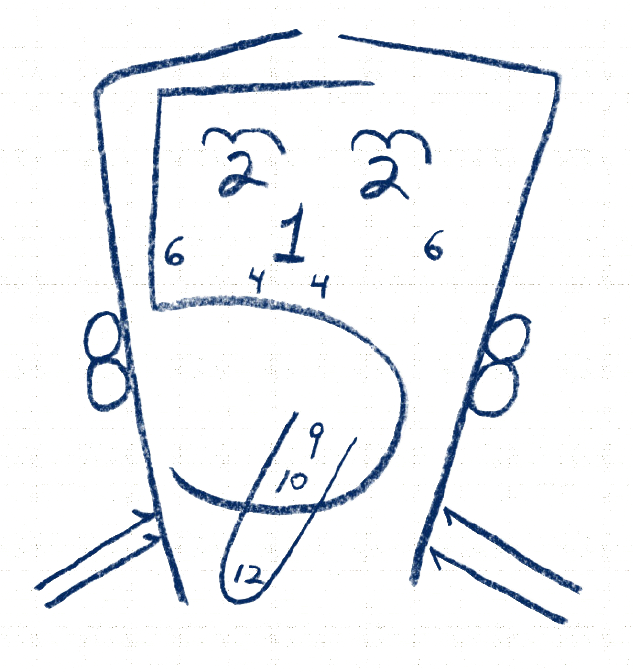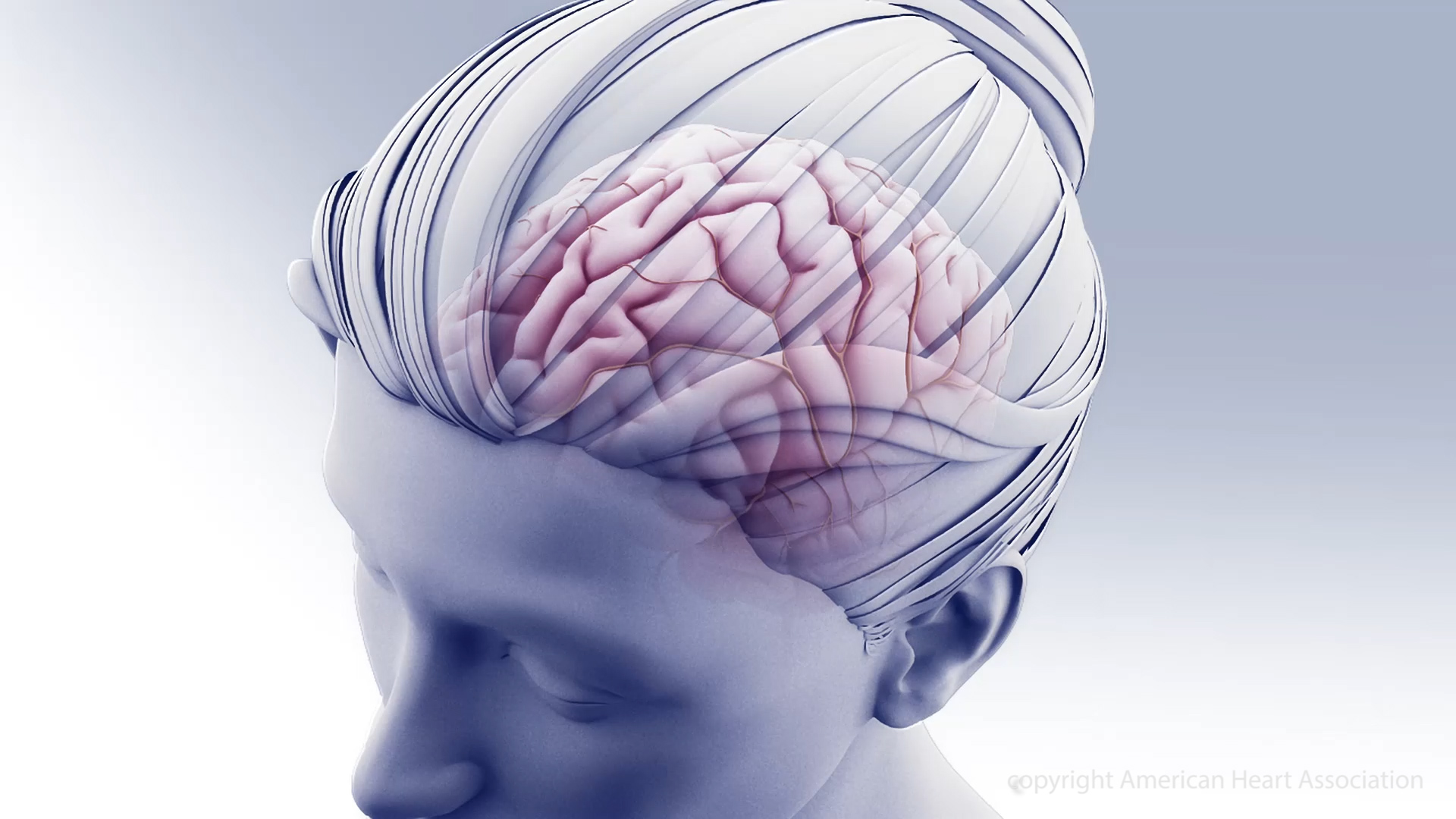Many years ago when I was in nursing school, I learned a saying that was supposed to help me recall the cranial nerves. You’ve probably heard it: On Old Olympus Towering Tops A Finn and German Viewed Some Hops. It didn’t make much sense to me, and it didn’t help me remember the cranial nerves. A few years ago, a colleague taught me a much easier way to remember the cranial nerves and their locations—by drawing a face and using numbers as the facial features. Each number represents one of the 12 cranial nerves, and the placement of the numbers represents the location of or an association with them. See Cranial nerves by the numbers
Cranial nerves by the numbers
The next time you’re trying to remember the locations and functions of the cranial nerves, picture this drawing. All twelve cranial nerves are represented, though some may be a little harder to spot than others. For example, the shoulders are formed by the number “11” because cranial nerve XI controls neck and shoulder movement. If you immediately recognize that the sides of the face and the top of the head are formed by the number “7,” you’re well on your way to using this
memory device.


Olfactory nerve (CN I)
Located in the nose, cranial nerve (CN) I controls the sense of smell. This nerve isn’t frequently tested, even by neurologists. However, suspect an abnormality in a neurologic patient who has a poor appetite.
To assess the nerve, use soap and coffee—both are easy to find on a unit. Or take a trip to the kitchen for cloves and vanilla. Don’t use a substance with a harsh odor, such as ammonia, because it will stimulate the intranasal pain endings of CN V. Have the patient close both eyes, close one nostril, and gently inhale to smell the scent. Remember to do both nostrils.
Optic nerve (CN II)
Located in and behind the eyes, CN II controls central and peripheral vision.
The fovea in the center of the retina is responsible for visual acuity in our central vision. Test one eye at a time. Ask the patient to read his I.V. bag. Then have him count how many fingers you are holding up 6 inches in front of him.
Test peripheral vision one eye at a time, too. Cover one eye and instruct the patient to look at your nose. Move your index fingers to check the superior and inferior fields one at a time. Ask the patient to note any movement in the peripheral visual fields.
Oculomotor nerve (CN III)
Also positioned in and behind the eyes, CN III controls pupillary constriction.
To test the patient’s pupils, dim the lights, bring the light of the penlight from the outside periphery to the center of each eye, and note the response. Use the mm chart to describe pupil size; descriptions such as “small,” “medium,” and “large” are too subjective.
Also, check where the eyelid falls on the pupil. If it droops, note that the patient has ptosis.
It’s easy to check cranial nerves III, IV, and VI together.
Trochlear nerve (CN IV)
Cranial nerve IV acts as a pulley to move the eyes down—toward the tip of the nose.
To assess the trochlear nerve, instruct the patient to follow your finger while you move it down toward his nose.
Trigeminal nerve (CN V)
Cranial nerve V covers most of the face.
If a patient has a problem with this nerve, it usually involves the forehead, cheek, or jaw—the three areas of the trigeminal nerve. Check sensation in all three areas, using a soft and a dull object. Check sensation of the scalp, too.
Test the motor function of the temporal and masseter muscles by assessing jaw opening strength. If you suspect a problem with cranial nerves VI and VII, check the corneal reflex with a cotton wisp since it’s easy to do while you’re checking trigeminal nerve function.
Abducens nerve (CN VI)
Cranial nerve VI controls eye movement to the sides.
Ask the patient to look toward each ear. Then have him follow your fingers through the six cardinal fields of gaze.
Here’s another easy technique you can use: With your finger, make a big X in the air and then draw a horizontal line across it. Observe the patient for nystagmus or twitching of the eye.
Facial nerve (CN VII)
Cranial nerve VII controls facial movements and expression.
Assess the patient for facial symmetry. Have him wrinkle his forehead, close his eyes, smile, pucker his lips, show his teeth, and puff out his cheeks. Both sides of the face should move the same way. When the patient smiles, observe the nasolabial folds for weakness or flattening.
Acoustic nerve (CN VIII)
Cranial nerve VIII, located in the ears, controls hearing.
Check hearing by rubbing your fingers together by each ear.
Glossopharyngeal nerve (CN IX) and vagus nerve (CN X)
Cranial nerves IX and X, which innervate the tongue and throat (pharynx and larynx), are checked together.
Assess the sense of taste on the back of the tongue. Observe the patient’s ability to swallow by noting how he handles secretions. Ask the patient to open his mouth and say AHHHHHH. The uvula should be in the midline, and the palate should rise.
Spinal accessory nerve (CN XI)
This nerve controls neck and shoulder movement.
Ask the patient to raise his shoulders against your hands to assess the trapezius muscle. Then ask the patient to turn his head against your hand to assess the sternocleidomastoid muscle.
Hypoglossal nerve (CN XII)
Cranial nerve XII innervates the tongue.
Ask the patient to stick out his tongue. It should be in the midline.
Look for problems with eating, swallowing, or speaking. You can check this nerve when you check cranial nerves IX and X.
So there you have it: No Olympus, no Finn, and nohops. Just an easy way to remember—and check—the cranial nerves.
Barbara Bolek, APRN, MSN, CCRN, PCCN, is a Staff Development Specialist at Provena Saint Joseph Medical Center in Joliet, Illinois.
Selected references
Donohoe Dennison R. Pass CCRN! 2nd ed. St. Louis, Mo: Mosby; 2000. Goldberg S. The Four-Minute Neurologic Exam. Miami, Fla: MedMaster Publishing Co; 2004.



















7 Comments.
Is it possible to damage the Glossopharyngeal nerve by eating a small garnish chip? My wife is convinced she has gpn because she has stabbing throat pain. Please help.
Thank you so much! Helped me so much for my Med Surg Exam!
Please note, the PDF issue has been resolved! If you click on the Download Article as PDF text, you will be able to download and view the visual referenced within the article. Thank you!
Please advise. When I click on the PDF icon I get the following:
‘Not Found
It looks like nothing was found at this location. Maybe try a search?’
Thank you!
Mary Girard
Okay so sending yourself an email doesn’t work. But if you click the PDF Format at the top of the page the article opens up, And the visual of the number face as well. Now this is helpful : )
I am having a hard time trying to figure out how to draw the numbers on a face to make any sense. I saved this to my computer. I saw no download option anywhere. I opened it up and no visual picture anywhere? Just as hard to understand as ever without the picture 🙁 Don’t suppose you could help?
Thank you. Much easier!